This is a Veteran Owned site
![]()
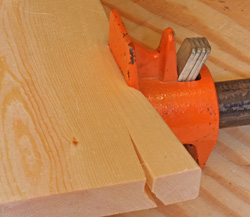 |
Modern woodworking clamps are capable of generating far more pressure than we need. that makes them plenty strong for normal use but for those who can't resist cranking their clamps down tighter and tighter bad things can happen now or unexpectedly down the road. Click image to enlarge |
Clamping Pressure
OK! You’re strong. Now get smart and lighten up on the clamps!
Text, photos and video by Tom Hintz
Posted – 5-4-2011
Whenever I do a review of woodworking clamps I try to include the amount of pressure they are rated to generate. I include that maximum pressure because I know that I will be asked about it almost immediately after I post the review if I leave it out. Initially I was surprised by how many people seemed to judge the capability of a clamp by the amount of pressure it is capable of exerting. Many do look at other features as well but a LOT of people equate huge amounts of clamping pressure with being able to successfully glue wood together. But why? The folks who make the glue do not advocate crushing pieces together. The people making the clamps don’t urge you to see how much pressure you can create. I know there will be someone on the woodworking forums that will tell everyone that “the tighter the better” theory is king and that alone should make us wonder.
More is Not Always Better
It is not hard to find the “more is better” concept alive and well in the United States. Remember that it was primarily Americans that spurred the marketplace to produce bigger cars, bigger boats, bigger houses, bigger hamburgers and all the while developing a keen interest in unnaturally large features of each other’s anatomy. So, learning that a large number of woodworkers demand clamps with large pressure numbers is not surprising.
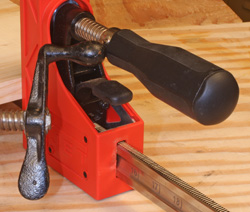 |
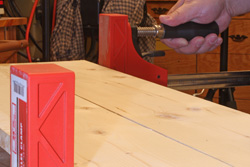 |
The clamp manufacturers are protecting us from ourselves with the size of the handles (left) that they put on clamps. This is usually an accident that comes from trying to prevent the operator from banging up their knuckles bit does work. The smaller diameter (right) handles make it easy to apply the pressure that you need but much harder to get carried away. Click images to enlarge |
|
One of the often-debated topics in woodworking is if it really is possible to squeeze all of the glue out of a joint with excessive clamping pressure. Even though everyone I can find that actually designs and manufacturers woodworking glues do not think that it is possible to squeeze all of the glue out, lots of people within woodworking remain certain that it is possible. That includes many of the woodworkers who routinely buy clamps with the highest pressure capability that they can get.
The instructions on all woodworking adhesives say that the parts should be clamped “firmly” or “tightly” and apparently a bunch of woodworkers to interpret this as a challenge. When the instructions say to apply clamping pressure until the glue rises from the joint that does not mean to crank on the clamps until the veins in your forehead also rise. There is nothing about modern glues that require every ounce of pressure you can crank into the clamp.
One of the glue designers I spoke with said that because woodworkers tend to apply too much glue to a simple joint, the excessive pressure actually can push enough of the excess glue out to reduce the film thickness closer to what the manufacturer wanted in the first place to develop the maximum strength. And for those who just felt justified the moral to this is to use less glue, not more force.
There are plenty of bad things that you can do with excessive clamp pressure that are not disputed. Damaging the wood itself by crushing images of the clamp face into the edge of the wood is just one. As the amount of clamping pressure increases so do the chances of forcing the wood to bow, particularly if any of the edges being joined are not perfectly flat and square, which is more rare than you might think. Even tiny variations along an edge can let one of the pieces being glued to begin deflecting one way or the other as pressure is applied.
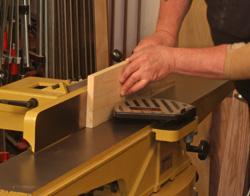 |
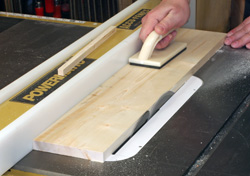 |
Making one edge perfectly straight (left) helps a bunch. So does taking that piece to the table saw and put the jointed edge against the fence so that you can cut the other edge (right) parallel to the first edge. Both of these steps help reduce the pressure needed and to help keep the clamps from forcing the pieces out of alignment. Click images to enlarge |
|
If all of the edges being joined are not parallel the pressure of the clamps may cause them to slide out of alignment. The glue, especially when too much is applied effectively lubricates the joint and encourages the wood to slide left or right under that pressure. If the glue film is thicker in some places and thinner in others, excessive clamping pressure will enhance the chances of that kind of miss alignment.
Wood Fights Back
One of the more common justifications for using big clamping pressures is to force gaps in mating edges closed. Some even describe squeezing a center gap closed as making a “spring joint”. One of my woodworking mentors was a retired master cabinetmaker who said that a spring joint is just an excuse from someone who didn’t have a jointer or couldn’t figure out how to work one. I have never found his advice to be wrong so far and have no reason to believe his description of a spring joint. Regardless of why the gap is there, you are counting on the power of clamps to close the gap and then the strength of the glue to keep it closed. On the surface both ideas sound like they should work. Often they do work, initially anyway. The thing about wood is that it has lots of internal strength and it remembers its original shape. The glue just might hold the joint together for a while but it is rare when the wood does not eventually win out.
The pressure within wood that has been forced into a new shape to eliminate a gap is relentless. As the glued up piece goes through the normal expansion and contraction cycles in response to temperature and humidity changes the elevated forces you squeezed into the wood with excessive clamping pressure keeps trying to return the wood to its original shape. When those forces cause a failure it might not involve the original glue joint. The next weakest point might be within the solid wood near that joint. I have had some very confused woodworkers wondering why their table snapped in half a good inch away from the nearest glue line. Now I know to ask if they squeezed a gap closed anywhere around the new break when gluing the piece up. More often than not, they did and now see what happens when the wood wins. We think that our machines and our glues are tough for just about anything but the wood is very patient and almost always much stronger and will take its time to show that it is still tougher.
Clamp It, Don’t Squish It
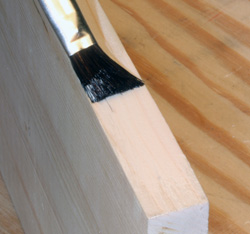 |
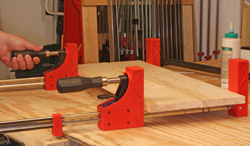 |
Apply glue in a very thin, consistent films on both pieces (left) to get the strongest joint. Apply firm clamping pressure but do not crank down on the handles! Then go back in five minutes or so to make sure that nothing has moved. while there, tweak the handles again to make sure they are still snug. Click images to enlarge |
|
From the beginning I have been taught that a solid glue joint comes as much from good preparation of the wood as from the glue itself. The technology of glues constantly gets better but nothing reduces the need to prepare the pieces of wood correctly. If you are forcing gaps closed with clamps, you are not preparing the wood properly or getting the strongest joint possible.
I realize that some closing with clamps will be necessary when gluing large flat surfaces. What we are talking about here is edge gluing as when building a panel. We have to get those edges straight and parallel if we hope to produce a flat, strong panel that will last.
Jointing at least one edge on each board straight is a good start. I know some people are able to do this with hand planes and if you can, that’s fine. However we do it (I will be the one at the jointer…) one edge has to be made perfectly straight with the edge square to the flat surfaces. Then we can go to the table saw, place that straight edge against the fence and cut the opposite edge parallel to the straight edge. I often make one final pass on the jointer to clean up saw marks. If your saw leaves a very clean edge it probably can be glued as is but the glue manufacturers stress that a very smooth, straight edge lets the adhesive form the strongest grip.
I try to apply an even, continuous film of glue to both sides of a joint that makes the wood look wet without showing a noticeable buildup of glue. Then assemble the pieces and apply clamp pressure. I turn the clamps down until just a little glue rises from the joint or I can feel a definite resistance to turning the clamp’s handle. I do not crank down on the clamps but rather tighten them only to where the pieces are held firmly together without distortion.
Video Tutor |
Another important step is to come back to the glue up in five minutes or so to be sure that none of the pieces have slipped out of position. After correcting any of those alignment issues I go over the clamp handles once more to be sure they still have that mild tension on them. If the glue film is a bit too thick in places the clamp pressure can push some glue out and that will release a little of the clamping pressure. Go back of the handles and just be sure that all of them are snug before leaving the assembly to dry thoroughly.
Conclusions
Learning to clamp things without using excessive clamping pressure is easy. However, if you still feel the need to squish pieces together with all of the force that you can muster you might also want to consider talking with the portion of the psychological world that deals with excesses.
For the rest of the woodworking world, learn to prepare the pieces for a glue up correctly, use glue sparingly and snug clamps up rationally. Save your urges to squash something for crushing aluminum cans or some other useful purpose. You can get way ahead of the folks in the squish-it club just by not having to flatten glue ups that were into an unwanted shape by excess pressure. Your projects will last longer, bottles of glue will last longer and your temperament just might brighten up a bit along the way.
Have a comment on this review? –Email Me!
All written, photographic and drawn materials are property of and copyright by NewWoodworker.com LLC 2000-2019. Materials may not be used in any way without the written permission of the owner.
